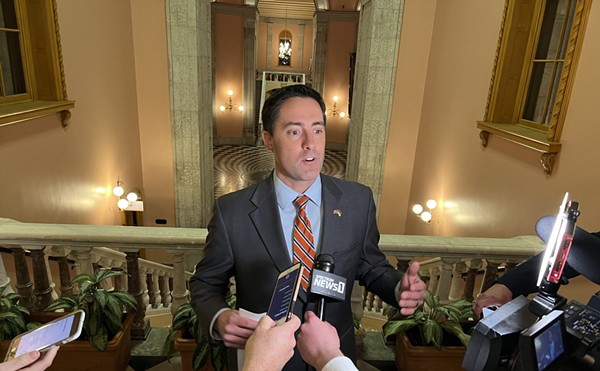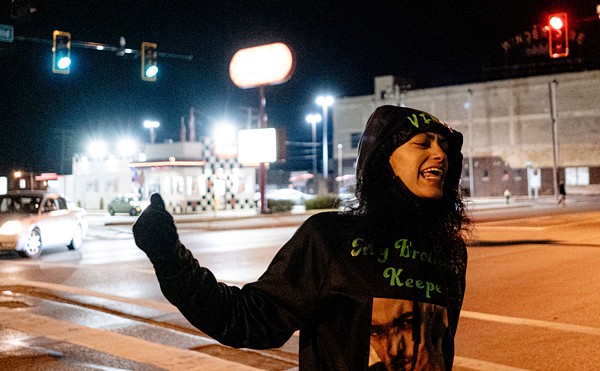SPACES director Christopher Lynn has grown accustomed to explaining himself. He's had a lot of practice lately.
That's what happens when you overhaul an institution that's been around for more than thirty years, especially if your constituents are artists. Founded in 1978, SPACES is a gallery on the West Bank of Cleveland's Flats whose mission is to give artists a "space" to make and show experimental work. It was always intended to be on the cutting edge. The new bent revisits ideas that were cutting edge half a century ago, updated for the internet age.
Lynn's first season at the gallery resulted in a bold shift in its longtime approach of being a place where you go to look at things to a place for the appreciation of ideas. The notion of artistic craftsmanship, as well as focus on materials such as paint, and employing specific techniques, has become secondary.
Has there been backlash? "Oh hell yeah," Lynn says, a subtle note of satisfaction detectable in his intonation. He seems to have expected as much. "And I especially find that it comes from artists."
Relaxed in jeans, sandals, and a blue and white cotton gingham shirt, the bespectacled 35-year-old sits in his tidy office, talking about the first year in which his ideas played out within the gallery's walls, if not actually on its walls.
"I wasn't specifically charged with change," Lynn says. "But I think our board and our audience are hungry for it."
Opinions to the contrary aren't hard to find.
SPACES — spelled with capital letters, though it's not an acronym for anything — rose out of the "artist spaces" movement of the 1970s, which happened when artists were looking for space to make and show work that didn't have commercial value. Sometimes it would involve a performance that couldn't be sold as an object for display; other times it might be a site-specific installation, or just something so far out that no one would want to buy it. There have been plenty of performances and films in the gallery's history, but the bulk of the shows consisted of objects meant to be looked at, even if they twisted your mind in new and unusual ways.
"We tend to think of ourselves as the research and development arm of the arts," Lynn says. R&D in the auto industry plays out in far-out "concept cars"; what SPACES has been doing under Lynn's leadership is more like toying with the concept of the car itself.
Hired in 2008, Lynn followed a succession of short-term directors who took over for Susan Channing, who stepped down in 2007 after running SPACES for 21 years. Lynn, a native of Utah who got an MFA in painting from Ohio State University, was previously director of the Gallery of Contemporary Art at the University of Colorado, and before that an assistant curator at DePauw University in Indiana. At the time of his arrival, exhibits were already set for his first season. But the recently concluded 2009-2010 exhibition season was all his, and it made quite a stir because of its almost total disregard of art having to do with the creation of objects; instead, it emphasized concepts. Not surprisingly, Lynn describes artists as "cultural contributors."
But the notion of Cleveland as a manufacturing town is part of the Rust Belt artist's DNA. You can see it in the subject matter, as multitudes of artists paint, photograph, and otherwise document the industrial landscape — the ruins of factories, the abandoned houses, the lake freighters coming and going. You can see it in the materials they use, as artists have transformed everything from old plywood to tar paper into painting surfaces, from chunks of steel to neon tubes as sculptural material, from video tape to blue plastic grocery bags as fiber to weave textiles. Indeed, one of the local art scene's strongest undercurrents in the digital age is old-school printmaking — burning metal plates with acid, or carving blocks of wood with sharp knives, rubbing them with ink, and transferring the image onto paper by cranking it through big steel presses.
It's also true that two of the biggest artists who emerged from the local scene and achieved fame elsewhere — superstar painter Dana Schutz and up-and-comer Amy Casey — are both painters, and for the sake of this discussion, fairly conventional ones.
"I do see the history of Cleveland artists as being materially based," Lynn says. "There has been considerable focus on material, craft, and basically the medium. But for me what's primary above that is concept. Without concept, it can be pretty, vapid, beauty-pageant kind of material."
His answer has been to shake things up by focusing on big ideas, including questions about the role and definition of art in an ever-evolving world. The season-opening exhibit, called Plum Academy, was built not as an art show, but as a term of classes whose intent seemed to be to give people a launching pad for musings about what an art gallery should — or could — be.
Opening night was presented as class registration day at a school, with patrons signing up for classes. One class, "Driver's Head," was facilitated from behind the wheel by artist Kristin Bly. From the course description: "Kristin sees himself as a very good driver, with excellent skills of observation, maneuverability, predictability, and driver multi-tasking. Almost unanimously, however, seemingly everyone who has ever been in a car or on a motorcycle with him has declared otherwise."
The class — the work of art, that is — involved up to four participants driving around the city with him, discussing the validity of their claims.
In another class, students explored the similarities between hip-hop graffiti and cake decorating.
The only thing that was actually adhered to the gallery walls while Plum Academy was in session was a band of black chalkboard paint, which visitors were invited to use for scribbling notes.
SPACES' winter exhibit consisted of the co-publication of a newspaper called Art Work. If Plum Academy introduced an academic bent and seemed more about explaining and discussing than appreciating beauty, Art Work veered wildly in that direction.
It amounted to 32 pages, many of them completely covered by text with no ads, much of it uninterrupted even by pictures. The first article began "We can see how the collapse of the economy is affecting everyone," and included the sentence "Letting the market decide, as Reagan, Milton Friedman, and other ghosts of capital past cried, has drastically limited what we think art is and can be in our society."
In other words, art can be about more than money. Subsequent stories are headlined "Art Versus Work" (which includes copious footnotes), "Selected Moments in the History of Economic Art," and "Nothing Changes When People Do Not Engage in the Long and Difficult Work of Building a Diverse, Multicultural Working Class Movement From the Ground Up."
Indeed, just as economic development types assert that Cleveland has to look beyond manufacturing to revive its economy, Lynn thinks the local arts scene has to move beyond it too.
"It's part of a larger discussion," he says. "The art world has been shifting in this direction for a long time. All over the world and especially in the U.S., manufacturing has taken a hit. The strongest companies now are in the business of ideas. Look at Apple."
But it hasn't been an easy sell. Artists, Lynn says, have been particularly vocal about the changes — especially the copious text associated with the exhibits. And, of course, the lack of stuff to look at.
Painter Arabella Proffer is best known for her classically styled, goth-influenced portraits of the fictitious aristocracy of her invented kingdom of Kessa. She came to Cleveland in 2004 and quickly got involved in the local scene, including a SPACES show featuring women painters. She became a member of the gallery and was heartened by what she saw as better communication from the administration when Lynn became director. Her judgment of his curatorial path, however, has not been so favorable.
"The shift seems too much like my worst classes in art school: all theory and no craftsmanship," she says.
"Most of the artists and collectors I know in Northeast Ohio are moved by more than just ideas when they want to create or collect anything. Lots of explanations, lots of text, and lots of lectures are fine, but that isn't always what people want to experience in a gallery setting — let alone [that] the term 'art' suggests something visual. Style, technique, and beauty should have a place in there too."
She adds that the first show under Lynn, Plum Academy, looked fun, but everyone she knows who saw Art Work "fell asleep or had no interest." She passed copies around in the Screw Factory in Lakewood, where she has a studio, and says artists there had a hard time getting past page one.
"I'm sure it appeals to a segment of people who want more conversations or a cerebral diagnosis of everything, but for those of us that enjoy the process of making something visually to evoke an emotion or conversation while taking time to devote to craftsmanship and style, it just all sounds like bullcrap. I don't like art that starves the eye or bores you while attempting to appeal to your intellect. To do that is selfish, and it often means the artist failed."
Cleveland artist Christopher Pekoc — known for his mixed-media works featuring stitched-together and manipulated photos of body parts — is featured in the permanent collections of the Cleveland Museum of Art and the Metropolitan Museum of Art in New York. He too is put off by SPACES' new direction.
"I feel quite distant from SPACES because of this new tack," he says. "It's our gut and intuition that really rules us, not our brains. After we are inspired by beauty, then we begin to intellectualize about meaning as a response. Conceptual art puts the cart before the horse."
In what sounds startlingly like the sale of derivatives on the stock market, Pekoc recalls an incident where a collector once paid for a certificate guaranteeing that a conceptual work had happened. The piece of paper was the only evidence of the work.
"Conceptual art basically started with Marcel Duchamp at the beginning of the 20th century, and I think it grew because it's easy to become a conceptual artist. It doesn't require any specific skills or craftsmanship. These trends swing like a pendulum. And I think this one is going to end, because it is tiresome. The bubble is going to pop."
Lynn's predecessor at SPACES, longtime director Susan Channing, says she has seen Cleveland artists become alienated by the gallery's current path, though she adds that she knows there are others whose work fits with Lynn's vision. She describes what she's seen as "sort of the 21st century version of 1970s conceptual art." After a pause, she adds, "and Chris wasn't born then."
"Craft hasn't been evident" in his first year of programming, she says carefully, but she knows the turn away from material finesse has been intentional. "That's not what he has been interested in. He's young and full of energy and willing to experiment and take risks in his own way."
"We did conceptual art, but not to the exclusion of everything else. So far, Chris' path has been to concentrate on that."
Bill Busta, who runs the William Busta Gallery on Prospect Avenue downtown, has been involved at SPACES as a trustee and curator through most of the gallery's history. He recognizes the differences between his gallery and SPACES. "I sell objects," he says. "I don't sell performances or concepts. I support artists who are active in the city, who are building careers with their work."
What he implies is that SPACES — as a non-commercial gallery — might not share the same concern. But in talking about the gallery, he asks a lot of rhetorical questions: Is it nostalgia to want to look at something beautiful? And is it more interesting to read about this work than it is to see it?
Busta recognizes the need for young artists to experiment and for a grass-roots organization to evolve. Perhaps, he says, if young people are attending shows, that's all the proof needed to demonstrate success. SPACES openings during the season have attracted lots of new, young faces — which is encouraging if only anecdotal evidence. But there have been fewer familiar faces too. Lynn says overall attendance has been down some during the last couple of years, but that's at least partly because of a reduction in the number of shows, due to a tightening of the budget.
As far as the art the guests are viewing, "It's a mystery to me" Busta says. "I'm 59. What do I know about what people are talking about in art school? Is SPACES moving to a type of art undefined yet, or am I just so fucking old that I've seen it all before? I think that stuff is really important, but it's not the only thing you do."
The third exhibit of Lynn's inaugural season, Detours, was built around the concept that there is value in shaking things up. Lynn chose five artists who would as a group give each other "obstructions," detouring them from their typical way of working. Each artist was paired with a hired color commentator (including this writer) who would chronicle what happened. The exhibit set Lynn and Busta off on a lengthy social media debate about the concept of "obstructing" the artists' work.
Among the participants in Detours was 2009 Cleveland Institute of Art grad Lauren Yeager, an artist perceived by her peers to make work that is subtly witty. Rather than be subtle, she was challenged to "be spectacular." Her response was to create a shared experience to be documented in the virtual world: She and some friends built a fireworks stand, giving each guest at the opening reception a cardboard tube of fireworks with the understanding that on a designated day and time, they would all take them someplace for a simultaneous launch, document the experience with digital photos, and post the photos online. Participants pushed pins into an Ohio map to indicate where they planned to launch their fireworks.
Detours was especially challenging for artist T.R. Ericsson, whose career thus far had focused more on materials and craftsmanship than did the other participants in the show. Ericsson studied portraiture briefly at the Cleveland Institute of Art before going to New York, where he made a living painting wealthy clients. After several years, his work took a more personal turn: In response to his mother's death from cancer, he began to make pictures starting with nostalgic photographs — such as his mother's house — then enlarged them and made silkscreens of the images. Instead of printing the screens with ink, though, he chose to do it with cigarettes: He'd light them beneath the silkscreen — sometimes hundreds of them — and the smoke would stain the paper behind it, leaving a sepia-toned, photographic impression literally made of nicotine smoke. It's an unusual medium rich with conceptual baggage, but it's also fairly conventional work.
For Detours, Ericsson — who, during planning of the show had mulled the ultimate meaninglessness of making art — was challenged to "live a meaningful life in seven days' time."
The obvious question: What does a person — any person — do with that task? And how does it play out in a gallery?
"When I saw that staring back at me, this assignment to live a meaningful life, what initially strikes me is the absurdity of it," Ericsson says. "It just became such a broad and vague notion, a completely conceptual notion. If you are asked to behave meaningfully, it's borderline angering. What does that mean, really? I'm a working artist. Give me a task and I'll do it."
His challenge resulted in applying a borrowed aphorism, "Life Is a Tear," to a wall in three-foot-high vinyl letters. But his difficulty with the project was emblematic of SPACES' shift in priorities.
If Lynn's approach to art is riling patrons, his approach to business has stirred another pot. The director has revealed his plan to sell the SPACES building — a three-story brick structure on the Superior Viaduct, which the gallery bought in 1990 and has owned outright since 2002. Lynn says being a landlord requires too much of the staff's time, and that the extensive condominium development that has emerged nearby — in addition to other West Bank proposals — could help them get a good price despite the economy. He says SPACES could eventually becoming a "homeless" organization, and he thinks that might suit the kind of programming they offer.
But critics say the rental units on the building's upper floors provide an important revenue stream, and that owning the space gives the nonprofit financial security it wouldn't have if they were renting.
The notion of selling the building is especially difficult for Susan Channing, who was director when the gallery bought the place in 1990 as well as when it was paid off with a grant from the Warhol Foundation. "Owning our building ensured longevity of SPACES and allowed us to concentrate on programming and paying artists," she says. "If we had continued renting, we'd have gone out of existence like so many other alternative galleries. There is no way we would ever have had enough money to pay the rent we would have been charged."
Still, she knows it's been difficult to find tenants because of the building's challenges: There's no elevator, and only the office areas are air conditioned. And as Lynn says, even though the building is in a neighborhood full of new condo development, and just up the street from Ohio City's lively West Side Market district, it's on a dead-end street.
Whatever happens with the building, Channing hopes the best for the future of the organization. "I do hope there will always be a physical presence so that when object-oriented art returns to SPACES, there will be a place to present it."
What's in store for the near future, however, continues along the conceptual path: The central exhibition on tap for this month, A Vague Whole, consists of three artists' "joint interest in a visually simple, yet relationally complex practice."
Also scheduled is a show by Milwaukee artist Paul Druecke, who "employs contemporary modes of communication to explore local communities," the gallery informs us. "In Cleveland Druecke will explore the way landmarks function within social spaces. His practice relies on community involvement and intensive research, leaving in his wake arts experiences that are both educational and profound."
Meanwhile, Cleveland artist Wes Johansen will examine the power and impact of TV on culture: "how television slips into everyday conversation, how the internet has the potential to replace the traditional TV-watching experience, and why television programming has such a presence in our daily lives and culture." He'll do this by creating "a gathering space in the gallery where people can watch TV together and discuss their 'cultural fixes.'"
As SPACES prepares for a new season, Lynn recognizes that there are lots of critical opinions about the way he's done things. He greets them with a quote from the Mexican writer Octavio Paz: "Our museums are full to overflowing with antiworks of art and works of antiart. More astute than Rome, the religion of art has absorbed all [its] schisms."
Send feedback to [email protected].











